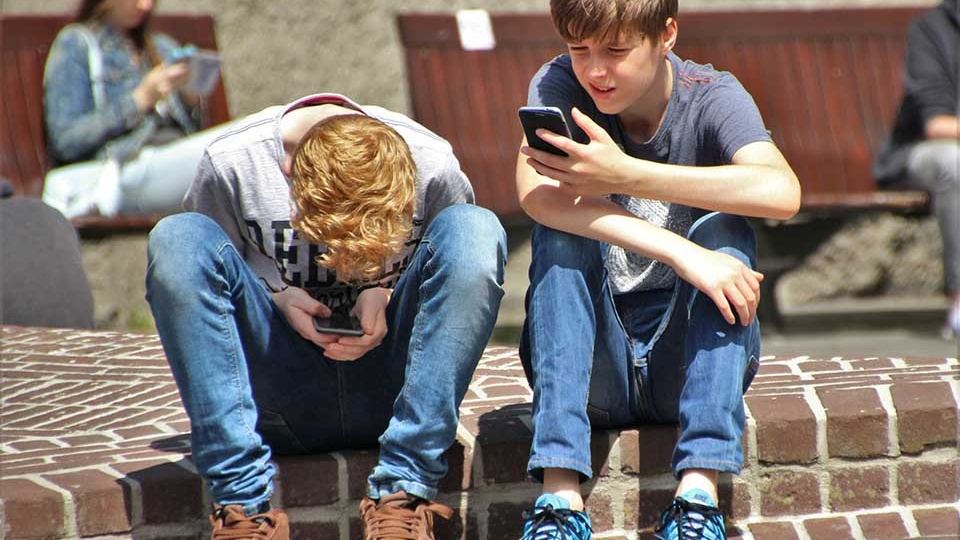The Screen Generation: How Technology Reshapes Adolescent Minds
By Archyde News
The pervasive use of technology from early childhood is profoundly impacting the development of children and adolescents, presenting a global challenge too their psychological well-being. Dr.Ana Bloj,a psychologist at the National University of Rosario,observes,”Only now are we seeing in adolescence the effects of being born with screens.”
While technology is universal, Bloj emphasizes that the term “adolescents” encompasses a diverse group shaped by their unique environments, socioeconomic conditions, and cultural backgrounds. Understanding these differences is crucial for addressing the challenges they face.
Bloj uses the example of the Netflix series Adolescence to illustrate cultural differences in emotional expression. She notes, “This is significant because it relates to the place that the adolescent body occupies in the interpersonal ties.Mobilizing the body is also a way to remove the boys from virtual reality,” she says. “Hugging is to include a series of sensations to which it is sometimes easier to arrive than with all the words of the world,” This highlights the importance of physical connection and its potential to ground adolescents in reality.
“Only now we are seeing in adolescence the effects of being born with screens.”
Dr. Ana Bloj, National University of Rosario
The Reconstruction of the Psyche
Bloj argues that adolescence involves a “rearming process” of the psychic apparatus, built upon the foundations of childhood experiences. This underscores the importance of early childhood development and the symbolic resources children acquire to cope with pain and frustration. Bloj asks crucial questions about the impact of virtual reality on this process:
And he wonders what symbolic, imaginary resources, of fantasies, that teenager will tell to psychically process what is painful, frustrating and that cannot be? How do you fix them with reality? How was the principle of reality that networks comes to Horadar already invite a hybridity that inhabits psychic life was armed in that child?
The intertwining of material and virtual realities presents a new frontier for adolescent development. “We are no longer in material reality exclusively, but also in a virtual reality that is intertwined and that makes up another type of psyche and another encounter with frustration.” This “hybridity,” she argues, can undermine the symbolic resources needed to navigate real-world challenges.
to illustrate, Bloj contrasts a child who understands the consequences of violence with one desensitized by virtual content. “One thing is to say ‘I want to kill him because he makes me bullyng’ but I am not doing it because I know he is prohibited,because I am a subject of culture and I know that there is a duty for my actions,and another thing is to say ‘I want to kill and kill’ as it happens in the series where,in addition,the protagonist does not record the fact of having killed. There is a hybridization that produces other feelings of reality.” This highlights the potential for virtual experiences to distort perceptions of reality and responsibility.
This is particularly relevant in the U.S., where school shootings have become a tragic reality. A 2023 study by the Pew research Center found that 81% of teens in the U.S. report experiencing online harassment, highlighting the pervasive nature of online violence and its potential impact on mental health.
The Alarming Rise of Bullying and Cyberbullying
According to a 2023 UNICEF argentina report, approximately 200,000 adolescents in Argentina experienced bullying, while over 400,000 witnessed it. While these numbers reflect the Argentinian context,the problem is globally relevant,including the United States. The CDC reports that nationwide, about 1 in 5 (20%) of high school students report being bullied on school property in the past year. Bullying, defined as a systematic and sustained power imbalance, manifests in various forms, including physical abuse, theft, and emotional manipulation.
Cyberbullying, an extension of bullying into the digital realm, involves repeated acts of aggression thru digital media. This includes sharing embarrassing photos, spreading rumors, and sending threatening messages. “Despite the particularities assumed by violence between peers, each of them is part of a complex family, social, economic, cultural and institutional framework that takes place in a given context.”
| Bullying Type | Definition | Potential Impact | Prevention Strategies |
|---|---|---|---|
| traditional Bullying | Systematic abuse involving physical, verbal, or emotional harm. | Anxiety, depression, low self-esteem, academic difficulties. | School-wide anti-bullying programs,bystander intervention training. |
| Cyberbullying | Aggression through digital media, including online harassment and spreading rumors. | Increased rates of depression, social isolation, and suicidal ideation. | Digital literacy education, parental monitoring, reporting mechanisms. |
“blocked parents” and the Digital Divide
Bloj introduces the concept of “blocked parents,” highlighting two key challenges: technology designed to circumvent parental oversight and adult struggles to understand the digital landscape. “As for the place of adults,the teacher refers to “blocked parents” in a double sense. On the one hand, as technology is designed for adolescents to block parents and in turn, in the face of the advancement of technology and the link established by boys with this, adults fail to understand logic.”
This digital divide creates a false sense of security, with parents believing their children are safe at home while they are, in fact, engaging in unsupervised online activities. Bloj warns, “There is a virtuality that enters through the screen window and young people are in a space that adults do not control, do not annotate and do not know.” This includes risks like online gambling and exposure to harmful content.
Parental responsibilities extend to “digital upbringing,” which involves actively engaging with their children’s digital lives. Though, many adults, overwhelmed by their own challenges, neglect this duty, leaving adolescents feeling isolated. Adults, also taken by a complicated life, escape that duty, from that function of accompanying adolescent processes and leave them very alone.
Addressing the Crisis: Education and Intervention
Bloj,as head of the Chair Interventions in Children and Adolescents of the Psychology career,emphasizes the importance of addressing the impact of technology on subjectivity from the earliest stages of education. She states that from the first classes they address the current conditions of subjectivity production, the problems that are generated from the use of the screens and how this models the subjectivities both in the field of the singular and the institutional and the community. The aim is to equip future psychologists with the tools to understand and address these challenges.
In a collaborative effort, the Faculty of Psychology of UNR, UNICEF Argentina, and the National Directorate of Mental Health and Addictions published “Guidelines for the first listening and the accompaniment of adolescents in the first level of attention.” These guidelines,which address the importance of active listening and support for adolescents,are being incorporated into training programs and resources.
To further disseminate these guidelines, the “first listening” podcast was created in collaboration with the UNR multimedial communication direction and is available on Spotify. This podcast aims to provide accessible facts and support for adolescents and those who work with them.
What are the most effective interventions and support structures for addressing the challenges of technology’s impact on adolescent mental health?
The screen Generation and Adolescent Mental Health: An Interview wiht Dr. Evelyn Reed
Archyde News recently sat down with Dr. Evelyn Reed, a renowned specialist in Adolescent Psychology, to discuss the profound impact of technology on the developing minds of today’s youth. Dr. Reed’s insights shed light on critical issues, including cyberbullying, parental challenges, and the changing landscape of adolescent mental health.
Understanding the digital Impact on Adolescents
Archyde News: Dr.Reed, thank you for joining us.We’re seeing increased concerns about how technology affects adolescents. What are the most notable psychological impacts you’re observing?
Dr. Reed: Thank you for having me. The pervasiveness of screens from early childhood is undeniably reshaping adolescent growth. we’re seeing effects on various aspects of social emotional regulation (SER), including self-esteem, social relationships, and decision-making. The “hybridity” of online and offline experiences is creating new challenges for their psyche.
Archyde News: You mentioned self-esteem. How exactly is technology influencing that particular area within adolescents?
Dr. Reed: Young people today are constantly comparing themselves to others online. The curated perfection they often see on social media can drastically affect their self-image. This can lead to increased anxiety and depression, as noted by various studies. The pressures to fit in,gain likes,and maintain an online persona have intensified in the digital age.
Navigating Cyberbullying and the Digital World
Archyde News: Cyberbullying is another significant concern.How does it differ from customary bullying, and what are its effects?
Dr. Reed: Cyberbullying is a particularly insidious form of aggression because it follows teens home.The constant barrage of negative messages, rumors, and harassment can have severe psychological consequences, leading to social isolation, depression, and even suicidal ideation. Unlike traditional bullying bullying, were teens get a respite at home, cyberbullying can be relentless.
Archyde News: The term “blocked parents” comes up frequently when these things are discussed. Can you unpack the concept of “blocked parents” as used in this context?
Dr. Reed: “Blocked parents,” in this context, refers to two things. Frist, technology is frequently enough designed to circumvent parental oversight, think of the various apps with their privacy settings, etc.Second,the technology and the digital experience of teens has evolved far faster than adults can grasp,so what teens interact with is wholly out of reach of their parents.
Building Resilience: Education and Intervention Strategies
archyde News: What kind of interventions and support structures do you believe are most effective in addressing these challenges?
Dr. Reed: Education is key. We need to equip adolescents with digital literacy skills to help them navigate the online world safely. schools and communities should implement anti-bullying programs and provide access to mental health resources. Parents also need to stay informed and involved in their children’s online lives, which, as you can imagine, can be quiet a challenge.
Archyde News: What do you think is the most significant challenge parents face today concerning adolescent technology use?
Dr. Reed: Balancing monitoring with privacy and trust is very tough. Parents need to be involved, but they also need to allow their children some space to develop autonomy. This could include digital upbringing, which needs to be actively managed.
Archyde News: Dr.Reed, what advice would you give to parents struggling to understand and support their teenagers in this digital age?
Dr. Reed: First, educate yourself. Learn about the apps, games, and social media platforms they use. Second, foster open dialog. Create a safe space where your teenager feels pleasant discussing their online experiences, both positive and negative. seek professional help if you’re concerned about your child’s mental health. There are resources available to support both you and your teenager.
Archyde News: Dr. Reed, thank you for sharing your expertise with us today. your insights are invaluable.
Dr. Reed: Thank you for having me.
We’d like to know: What are your biggest concerns about the impact of technology on teenagers? Share your thoughts in the comments below.








